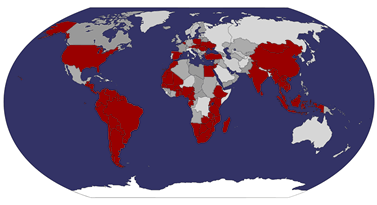Ukraine is a country that may not want to be like Russia, but that has too strong of a Russian influence to escape it quickly. Since Americans can't get Russian visas in Asia (I'll spare you the details), we leap-frogged over Russia straight to Ukraine. Ukraine had to serve as the closest we would get to the heart of the Soviet Union. The country served to show us how little Russian I actually speak (basically, none) and how little we knew about Chernobyl (basically, none).
How do you know that you have reached the former Soviet Union? If you find yourself on a plane with a flight attendant who looks like this, you have probably reached the Soviet Union. If the man standing behind her looks like this man, you have definitely reached the former Soviet Union.

Ukraine, like Russia, has tons of Russian Orthodox churches that have had a resurgence in popularity since the fall of the Soviet Union. Strangely, we saw many places selling these gold tops for your cathedral. Can you buy one of these for your house? Apparently.

This is the primary church in the Lavra Monastery of Kiev, which is most famous for mummified monks buried in catacombs underground. Unfortunately, the monks are heavily shrouded and no more than a few dried arms can be seen. Just as unfortunately, no pictures are allowed of the monks, so this church is as close as you'll get in this post.
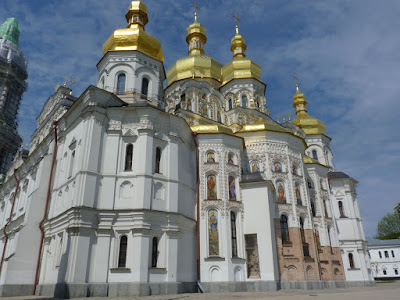
Easter eggs are very popular in Ukraine. Since it was recently Easter, the church still has an Easter egg sculpture outside. No chocolate bunnies in sight, though.

It happened to be some kind of saint day while we were visiting, and tons of people were out to celebrate. Here is the processional.
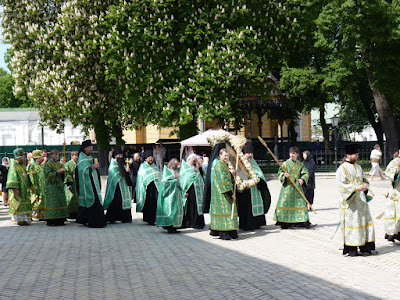
Here is our favorite of the priests. Part leprechaun, part hippie, part priest.

The monastery follows in the footsteps of Gregor Mendel and has a lot of crazy flowers. Maybe they actually breed them or maybe they just get them from the landscapers, but many are really beautiful. Here are some crazy colored pansies.
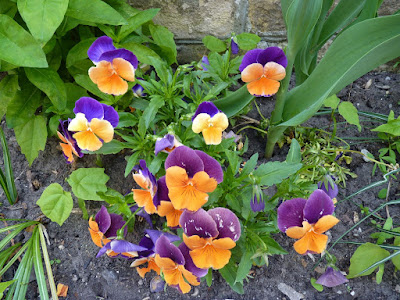
And here is a nicely fringed tulip.

Overlooking the city of Kiev is this very shiny statue representing the Motherland. It seems like they should get it a job as the spokesperson for a shiny watch brand. Forget your celebrity spokespeople, Rolex, and switch to something that looks like a giant watch for your spokesperson.
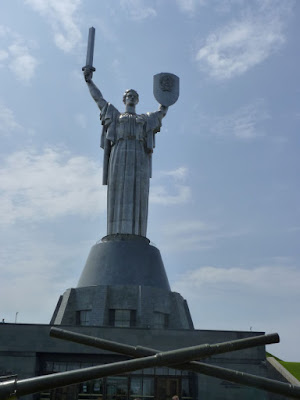
Inside the Saint Sofia Church in Kiev, no photos are allowed, and they had people watching us everywhere. However, the woman let us take a photo of this piece of art that is the size of a huge wall and is created using thousands of Easter eggs, each of which is individually decorated. It is based on one of the murals that appears in the church from the 1200s. Again, no chocolate Reese's bunnies in sight.

Saint Michael's Church was rebuilt in 2000 after the Communists decided to destroy it at some point in the past. The new one is very nice from the outside. The inside is a bit crowded with murals and icons everywhere, but most Russian Orthodox churches have too much bling inside for my tastes.
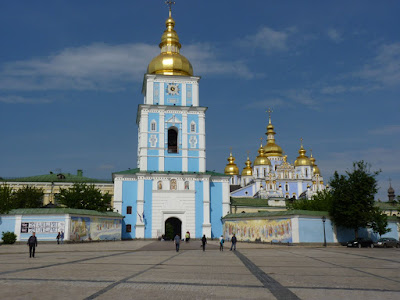
We made it to one classical music concert in Kiev. The full Philharmonic wasn't playing while we were there, but we caught a piano/violin concert in the Philharmonic hall. We bought the cheapest possible tickets for $3, which worked out well when only about 20 people showed up for the concert and they moved us to the center of the third row.

At the Chernobyl Museum, we learned a bit more about the tragedy of Chernobyl. Thousands died and are still dying from being exposed to radiation. The craziest part is that the facility was still active until 2000. We thought they had closed it since they no longer let people live within 20 miles of the place, but apparently it was still okay for people to work there. Also, you can take a tour to the still very radioactive area if you pay enough money (about $150). This didn't sound like the smartest idea to us.
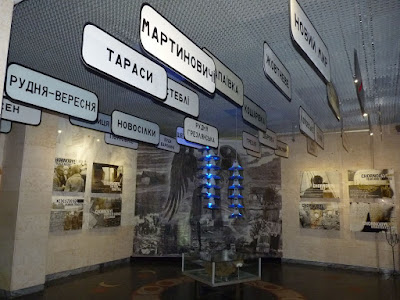
St. Andrew's Church is another famous church of Kiev. It was closed for repairs when we were there, but still looked nice from the outside. Glad to see that they are keeping my namesake church in good repair.

The subways of Kiev are very Soviet. They are deep, deep underground and have escalators that are so long that you can't see the top when you get on at the bottom. The escalators move about twice as fast as US escalators. We saw many people sitting down for the ride, though making out seemed to be the most popular pastime.
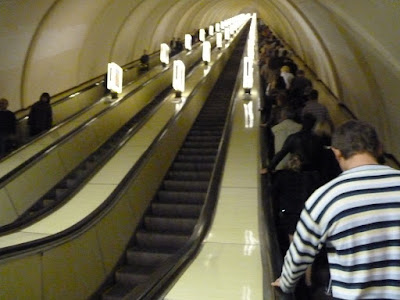
Tara with Mikhail Bulgakov, author of Master and Margarita, a rather good (and sometimes strange) book about Russia and the devil. You've probably never heard of it, but it is very famous for Russian speakers. Go read it. Or see if there is a movie, but I think it would be pretty tough to film.

In WWII, 100,000 Ukrainians, mostly Jews, were killed in a park outside Kiev. This is the only memorial that now exists to those killed. Depressing.
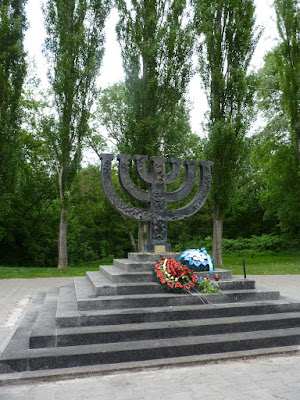
From Kiev, we journeyed to the Crimea. After getting off of our train, we took the "longest trolleybus in the world" to Yalta. A trolleybus apparently means that a normal bus connects to power lines overhead. No tracks, but it can't get too far from the lines overhead or the cable disconnects, which happened a few times on our three hour trip.
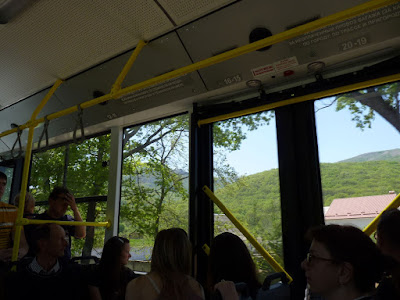
In Yalta, we rented an apartment from a little old lady at the bus station. The first place she showed us was nice, but had only one tiny bed located in the kitchen. We were confused and surprised when the second that she showed us was exactly what we wanted.

Yalta is located on the Black Sea. It becomes a big tourist destination during the summer, but we were there before things got too crazy. Lots of flowers in bloom for springtime.

Yalta still has a very nice Lenin statue. He used to look out towards the harbor, but now looks upon the McDonald's that has been built between him and the harbor. He told me that he prefers the ice cream from McDonald's, but his friends look down upon him for going to this bastion of capitalism for his ice cream.
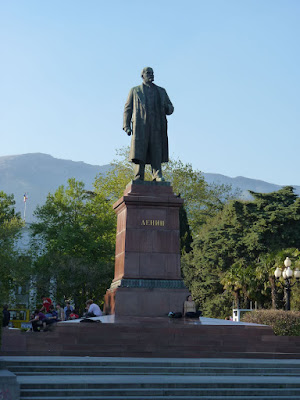
A dolphin! I swear! We could see dolphins swimming from our view above on the cliff, but this was as close of a picture as we could get. Dolphins would be easier to photograph if they stayed in the air. Maybe some kites could be attached to their backs?
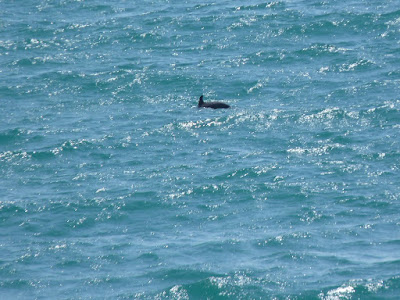
The cable car up the mountain outside Yalta. The second part is so steep that you transfer to a second cable car that goes at a steeper incline. The swaying of the car made Tara motion sick.
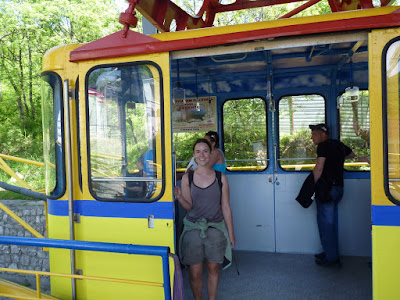
The view from the top of the mountain gives a good perspective on the town. That sea doesn't look black to me. We are renaming it the Blue Sea. Come to think of it, why is that name not taken?
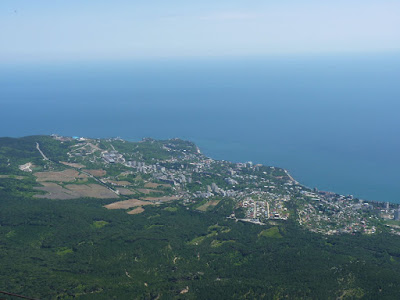
Yalta was home to the peace talks that ended World War II in Europe. Roosevelt, Churchill, and Stalin carved up Germany and other parts of Europe in this palace over several days in 1945. The palace had originally belonged to the Romanovs, but they were killed a few years after its completion.
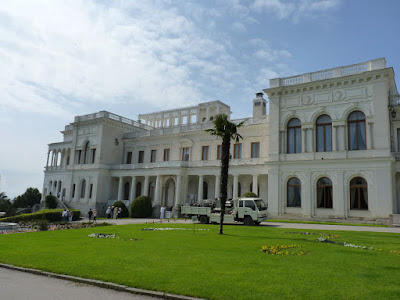
This was the dining room in the original palace and became the main meeting room where all the important meetings occurred at the Yalta conference.
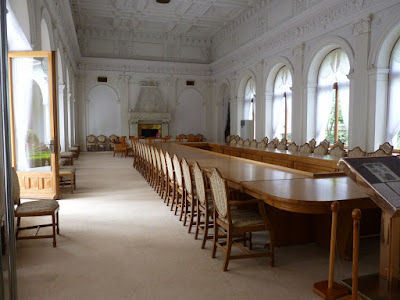
After trying to lose her hat at least a dozen times, Tara has finally lost her baseball cap. This means that she had to be creative when we out for a hike in the sun. She created this stylish new look, which is sure to catch on the world over.
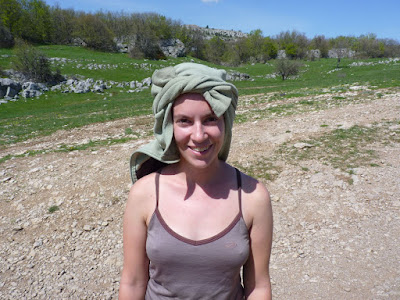
While walking down a path, we found dozens of these worms hanging on nearly invisible threads blocking our way. No idea why they hang like this, sometimes 20 or 30 feet off of branches. My best guess is that they are actually crazy blood-sucking monsters and wait to latch on to passing people, but it didn't seem to want to eat Tara when I tried to attach it to her.
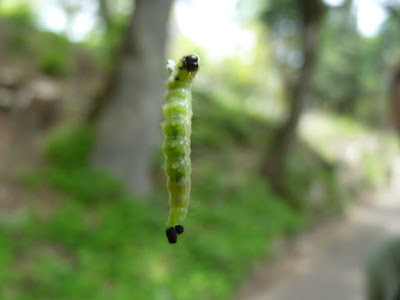
That brings us to the conclusion of Ukraine. Despite some language barriers (no one in Ukraine speaks English), we had a good time visiting and were there for a beautiful part of Spring. We hopefully won't glow in the dark after being so close to Chernobyl.
 M&Ms come in three standard flavors in Ukraine: plain, peanut, and...this one. We couldn't read the package, so we just bought it to try. Turns out to be hazelnut. I thought they were good, Andy thought they were gross. Europeans definitely get a lot more hazelnut-flavored candies than we do in America.
M&Ms come in three standard flavors in Ukraine: plain, peanut, and...this one. We couldn't read the package, so we just bought it to try. Turns out to be hazelnut. I thought they were good, Andy thought they were gross. Europeans definitely get a lot more hazelnut-flavored candies than we do in America. McFoxy is the local McDonald's knockoff (although Ukraine has McDonald's, too). Their menus are basically identical (Kids can get a FoxyBox instead of Happy Meal)...except that McFoxy also sells these unidentified fried balls. We tried an order and they turn out to have processed chicken inside, kind of like a nugget. Not so good.
McFoxy is the local McDonald's knockoff (although Ukraine has McDonald's, too). Their menus are basically identical (Kids can get a FoxyBox instead of Happy Meal)...except that McFoxy also sells these unidentified fried balls. We tried an order and they turn out to have processed chicken inside, kind of like a nugget. Not so good. Ukraine has cherry nectar! Ah, my long-lost love from Turkey (if I could marry a TetraPak beverage...). Not nearly as many brands are available as in Turkey, but this one was pretty good.
Ukraine has cherry nectar! Ah, my long-lost love from Turkey (if I could marry a TetraPak beverage...). Not nearly as many brands are available as in Turkey, but this one was pretty good. Cherry drinkable yogurt. It was OK. Eastern Europe has a lot of yogurt brands, but none have wowed me so far.
Cherry drinkable yogurt. It was OK. Eastern Europe has a lot of yogurt brands, but none have wowed me so far.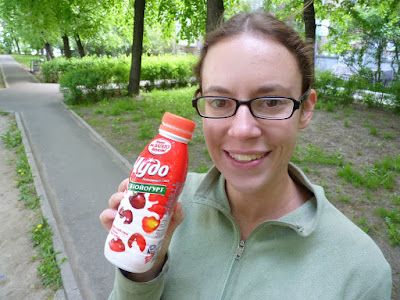 Blinis are the Ukranian version of crepes, often served with some fruit jam for dessert. Good stuff.
Blinis are the Ukranian version of crepes, often served with some fruit jam for dessert. Good stuff.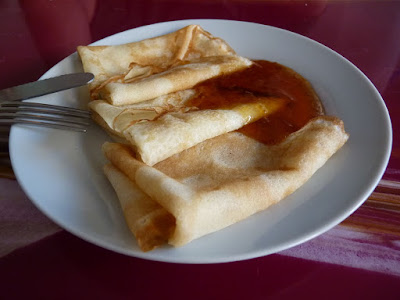 I finally got to try Chicken Kiev...not in Kiev, but in Yalta. Turns out that the breading is sweet, so it's kind of like chicken in a donut. That squirts hot butter sauce when you slice into it. Ukranians love their butter sauce, and I am not complaining about this.
I finally got to try Chicken Kiev...not in Kiev, but in Yalta. Turns out that the breading is sweet, so it's kind of like chicken in a donut. That squirts hot butter sauce when you slice into it. Ukranians love their butter sauce, and I am not complaining about this.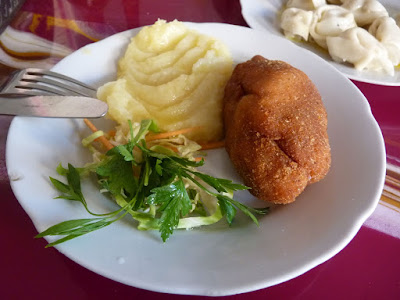 Smaller dumplings called pelmini are also popular in Ukraine, and when we had a kitchen in Yalta, we cooked up some frozen ones that we found on sale at the grocery store. How much is a bag of on-sale frozen potato pelmini in Ukraine? Around 40 cents US. We used to get on-sale frozen pierogies in the states for $1 and thought that was an amazing deal until we got these.
Smaller dumplings called pelmini are also popular in Ukraine, and when we had a kitchen in Yalta, we cooked up some frozen ones that we found on sale at the grocery store. How much is a bag of on-sale frozen potato pelmini in Ukraine? Around 40 cents US. We used to get on-sale frozen pierogies in the states for $1 and thought that was an amazing deal until we got these. In our world travels, we have seen ice cream in many forms, but never in a frozen sausage until Ukraine! Convenient for slicing...not so convenient for saving for later, so we just had to eat it all in one go. Cherry flavor, of course. Hooray for a country that loves cherries as much as I do!
In our world travels, we have seen ice cream in many forms, but never in a frozen sausage until Ukraine! Convenient for slicing...not so convenient for saving for later, so we just had to eat it all in one go. Cherry flavor, of course. Hooray for a country that loves cherries as much as I do! Last shot from a restaurant in Yalta--Andy's beef tenderloin, which came in a kind of vegetable soup, and some pelmini (not as cheap as the ones we cooked ourselves). It was all OK, but it was no Puzata Hata meal. They need to open a Yalta branch!
Last shot from a restaurant in Yalta--Andy's beef tenderloin, which came in a kind of vegetable soup, and some pelmini (not as cheap as the ones we cooked ourselves). It was all OK, but it was no Puzata Hata meal. They need to open a Yalta branch! I had really low expectations for Ukranian food, so I was seriously pleasantly surprised at how many tasty dishes I ended up eating. And I was happy with all the cherry products, too. Who knew Ukraine was a hot culinary destination? Go now, and bring me back some dumplings.
I had really low expectations for Ukranian food, so I was seriously pleasantly surprised at how many tasty dishes I ended up eating. And I was happy with all the cherry products, too. Who knew Ukraine was a hot culinary destination? Go now, and bring me back some dumplings.
